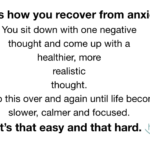Mental health challenges in teenagers are real and widespread.
Teens have endured unprecedented rates of anxiety and depression the past couple years.
Besides the obvious emotional toll of covid-19, remote learning and isolation, there’s the deficits in social skills, too much social media, and too many self-diagnoses of social anxiety.
And then there’s the parents.
As a parent, I’m on your side. And ever gracious that my kid was an older teen when the pandemic hit.
Be that as it may, anxious adults raise anxious children.
Consider this article a holistic resource to share with your teen to help support physical and mental health. I’ve started with the basics as it’s hard to execute coping skills if they’re sleep-deprived and punch drunk from too much tech.
1. Get ‘em in school. I recognize this hinges on the course of the pandemic, your school board, local government and CDC recommendations. However, prior to the pandemic my private practice was flooded with referrals from stressed-out parents because their stressed-out middle and high schoolers refused to attend school. Besides federal and state compulsory attendance laws, the worst thing for anxiety is to allow your kid to stay home because they don’t like school, their peer group, their teachers or whatever. Sadly, a year or more of remote learning has unwittingly contributed to a generation of youth who want to “live life” inside their bedrooms.
Parent Support: Since most adults don’t plan on subsidizing their child forever, insist they attend school daily (covid-related protocol, and medically fragile status, exempted). By not enabling them, you are helping your teen function socially, emotionally and academically. They can cry, complain and tantrum until the Compulsory Attendance Cows come home, but there’s not a place “where anxious people live” they can move to when older.
Parental, ‘This one’s hella tough’: Read the book Parents In Control by Gregory Bodenheimer. I was trained in this parenting model as a rookie therapist, and thank goodness. I wasn’t yet a mom, and this book was a game changer for establishing firm rules around non-discretionary behaviors.
Parental, ‘This won’t work in my home’: Even if your child has a mental health diagnosis (we all have something) or a history of difficulty in school, be open-minded and optimistic that things could be different. Many parents with unresolved issues around school and authority side with their child, rather than focus on the benefits of learning to work through peer and academic issues.
2. Schoolwork before tech. Regardless of their online habits at the beginning of the pandemic, kids need firm boundaries around tech access now more than ever.
Parent Support: Stow their phone, tablet, laptop, and if necessary, desktop port plug, Sunday – Thursday from 9:00 pm – 7:00 am. Ideally, you want to store their devices in your room so they can’t get to them in the middle of the night.
—Create a schedule for when they’re allowed to use tech devices. For example, 15 minutes before school, after school, upon homework completion, etc. You know your kid best, so choose an appropriate schedule. Make the new rule clear by using brief, boundaried language so your kid isn’t caught off guard. Additionally, know their usernames and passwords, and check on them often while online. If they’re starting to become emotionally dysregulated, intervene before they crash into a full-blown breakdown.
—Check their search history. Yeah, yeah, I know…they delete it. However, with due diligence and apps you can monitor if they’re watching Outer Banks in Biology class.
Parental, ‘This one’s hella tough’: Totally. Especially when they tantrum and throw their dinner plate across the dining room floor, barely missing the hapless family dog because you unplugged the wireless router. Oh, wait…that one came from my inside my head…Like I said, Parents In Control.
3. Establish a consistent bedtime. This one’s so obvious I feel like I’m insulting your parental intelligence. But no one, especially teens and their developing brains and growth spurts function on fumes.
Parent Support: Really follow #2 to optimize your kid’s ability to unplug at night. According to research by Johns Hopkins University, teens need 9 to 9½ hours of sleep nightly for cognitive maturation. Quality sleep also helps protect them from serious consequences like depression or drug use.
Parental, ‘This one’s hella tough’: Ban tech from the bedroom at least one hour prior to bedtime. Using tech at night not only reduces sleep time, it exposes them to a blue light that suppresses the sleep-inducing hormone melatonin, making it harder to fall asleep.
4. Lifestyle Essentials. AKA, Those Other Important Things. Make sure they drink plenty of water, eat well-balanced meals (laughing as I type that), exercise and get outdoors.
Parent Support: Be your kid’s prefrontal cortex — the area of the brain which controls decision-making, risk-taking, etc. Sometimes you have to bribe them with a privilege so they’ll eat a banana in the morning. Other times, it may be an extra helping of dessert when they finish their broccoli, or take a walk after dinner. Not unlike when they were a toddler.
5. Have the Cosmetic Surgery Talk. Beauty standards have changed drastically over the years. Teens are concrete, literal thinkers. Sadly, marketers manipulate this developmental deficit to their advantage. Most young people don’t realize that puberty and aging out of adolescence doesn’t plump your lips and glutes or create cat eyes and hip dips.
Nothing against procedures to help you feel more confident, however, the lack of honesty from influencers is negligent. The sheer number of teen clients and young adults who self-diagnose with body dysmorphia is heartbreaking and wholly unnecessary.
Parent Support: YouTube has educational, insightful cosmetic surgery analyses by Board Certified Surgeons. You can watch Doctor Gary Linkov, and Anthony Youn, MD, who offer non-judgmental critiques of celebrity procedures that cut to the chase (no pun intended).
Social-emotional learning is the focus for Steps 6-10. These foundational steps can help your teen learn to self-sooth, build self-awareness and problem-solving skills.
6. Slow, deep-breathing. Nothing calms an anxious mind + body faster than intentional focus on brain breaks. The thing about anxiety and deep-breathing many is the connection to calm. For this reason, it’s critical to educate teens about why we need to focus on the breath. Only when the mind slows down are we’re able to focus and think with our rational mind, not our impulsive, primitive, irrational mind.
Parent Support: A simple way to bond and normalize stress is to practice deep-breathing together. Common patterns are the 4-7-8 (inhale for a count of four, hold for a count of 7, exhale for a count of 8). Repeat three times. Make sure to relax your shoulders, rest your palms comfortably at your sides or in your lap, and close your eyes (if this feels safe for you). You can always start with the 3-3-3 or whatever sequence you prefer.
This link contains a variety of deep-breathing exercises.
7. Mindfulness. In its simplest iteration, mindfulness is paying attention to what you pay attention to. It’s being grounded in the here-and-now and resisting the urge to dwell on the past or get stuck in the future’s ‘what ifs’. Mindfulness also teaches us how to recognize, manage, and learn from difficult emotions.
Parent Support: Remind your teen that stress is inevitable, but being stressed out is an option. After they roll their eyes and shake their surly head, gently encourage them to expect stress in daily life. Normalize healthy anxiety vs unhealthy anxiety. For example, if you’re worried about tomorrow’s math test, you can mobilize the nervous energy to review concepts, rather than watch Netflix. Mindful attention to consequences can serve as a motivator that Emily in Paris can wait for the weekend.
8. Thought Awareness. Ever ask a teen anything and the answer is “I don’t know.” Speaking of, I have a therapy rule when working with teens: “Let’s pretend you did know.” This usually garners a laugh or two and presents a solid segue to thought awareness. Because we cannot see inside our minds, it can be difficult to believe that our thoughts don’t automatically happen to us. For this reason, I introduce elements of Cognitive-Behavior-Therapy (CBT), and The Feeling Balloon Exercise early on.
Parent Support: Talk about thoughts and feelings. Often teens don’t understand what they’re thinking or how to identify their feelings. Or how to distinguish between the two (many adults get tripped up, too).
The basic distinction is a thought is something we tell ourselves about a situation, “Things will never work out for me,” and feelings are adjectives: hopeless, sad, defeated, exhausted.
Here’s a summary of CBT:
Thoughts ———> Feelings ———> Actions
Uncomfortable event: A friend ignores you at school.
Thought: Now I literally have no friends.
Feelings: Rejected, confused, angry, sad.
Actions: I’ll ignore her back and act like I don’t care about her.
The goal is to come up with a more realistic reason why a person might ignore another. With a less catastrophic assessment (thought), the subsequent feelings will be less intense, leading to healthier actions.
When kids are taught that our thoughts don’t always represent reality, or that feelings don’t last forever, they are more apt to adopt a flexible mindset. And they’re so self-centered…Maybe, just maybe, the friend is going though something and wants to be left alone, or doesn’t know how to identify their feelings…
For extra support click to download the Feeling Balloon Ex. (although therapeutic in nature, it can be modified).
9. Practice Perspective. Teens are self-absorbed and dramatic by nature. During those times they resist your offers to help problem-solve, remember they don’t have the frame of reference adults do. A few questions posted to the fridge or on the front door can help them get out of their head and into reality.
Parent Support: Lead with warmth and understanding, especially when they’re acting out. Encourage them to ask questions, rather than make black-and-white assumptions. For example, when faced with a tough event:
—Is this thought based in reality or worst-case scenarios?
—What’s a different way of viewing this situation?
—Is this thought helping me feel how I want to feel?
10. Teach “Healthy” Relationships. The teen years are ripe for learning about interpersonal relationships. Heartbreak, sexual ambiguity and adolescent awkwardness, notwithstanding, time is on their side. Because my specialty niche is high-conflict divorce and co-parenting, I’m especially passionate about this one.
Parent Support: Regarding friends, discuss the difference between bullying and teasing. Bullying is repeated hurtful behaviors done to the same person with the intention to cause harm, while teasing involves annoying and irritating behaviors, though not malevolent.
Talk about the nature of their dynamic with friends. Do these relationships revolve around drama or gossip or kindness and reciprocity? Who can they identify has their back? And vice versa.
Have the sex and sexual orientation talks. Often.
If you’re divorced, talk with your teen about why. Speak in age appropriate language that’s brief, boundaried and blameless. Despite what lead to the break-up, they deserve to know they weren’t the cause.
If they’re dating or involved in a romantic relationship this short post identifies healthy traits, while this one outlines warning signs.
It would be great if we could vaccinate away the emotional toll of the pandemic. Thankfully, kids are adaptable and adults are resilient. Think of it this way: you’re going though it together and you’ll get through it together.
Please share this post with someone who could use the support and guidance.
*****








